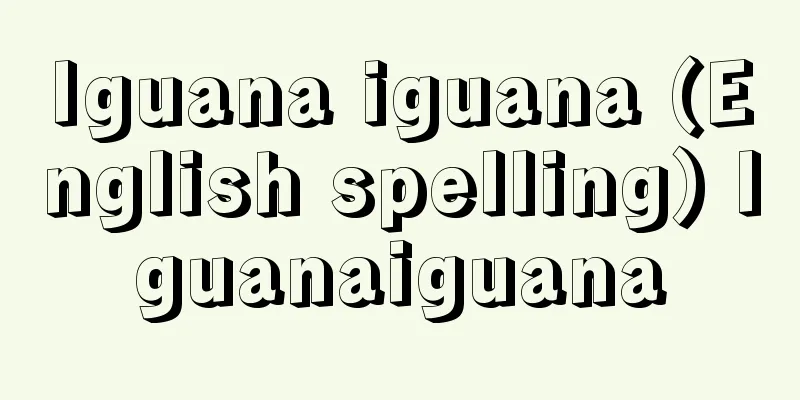Cartilaginous fish - nankotsugyorui (English spelling)

|
In animal taxonomy, they are fish that belong to the phylum Chordata, subphylum Craniata, infraphylum Vertebrata, and superclass Gnathostomata, and are part of the class Chondrichthyes. Extant species are divided into the subclass Euselachii, infraclass Elasmobranchii (sharks and rays), and subclass Holocephali (holocephali, chimaeras), which contain approximately 1,200 species. Note that the subclass Euselachii includes fossil species (fossil groups), so some researchers classify the infraclass Elasmobranchii, which consists only of extant species, as the subclass Elasmobranchii in contrast to the subclass Holocephali. Morphologically, they share many of the characteristics of Paleozoic fishes, and so they were once considered a more primitive group than the bony fishes. However, the cartilaginous fishes have some highly specialized characteristics, and it is now believed that the two groups evolved separately and independently. Their internal skeleton is made of cartilage, their skull is a single continuous box of cartilage and not made up of many bones, their teeth are arranged in several layers and if some of the functional teeth are damaged all of the teeth in the inner layer become functional teeth and are replaced by them, they usually have several pairs of gill slits, each fin ray is horny and not segmented, they have no swim bladder or lungs, their scales are pellucid scales with the same structure as teeth except for degenerate scales, they have a spiral valve on the inner surface of their intestine and a developed rectal gland at the posterior end, their caudal fin is heterocaly, and males have large copulatory organs on the inner edge of their pelvic fins and internal fertilization occurs. In elasmobranchs, each gill slit opens separately onto the body surface and the notochord is constricted at each vertebra, whereas in holocephalics, each gill slit opens onto the body surface through a common gill opening and the notochord remains cylindrical throughout life. Cartilaginous fishes usually mate and undergo internal fertilization. There are two reproductive methods: oviparous, in which eggs enclosed in an eggshell are laid, and viviparous, in which embryos are laid (including what was previously called ovoviviparous). According to the definition in 2016 (Heisei 28) by Japanese fish researcher Nakaya Kazuhiro (1945- ), and the definition in 2020 (Reiwa 2) by Nakaya et al., there are three types of oviparous. (1) Short-term monoplomate: These fish have one shelled egg in each oviduct and lay eggs immediately (such as the tiger shark and cat shark). (2) Retentive monoplomate: Each oviduct has one shelled egg, which is retained until the embryos reach a certain size before spawning ( Cephaloscyllium sarawakensis ). (3) Polyoviparous: These species have several shelled eggs in each oviduct and lay them sequentially (e.g., some species of the catshark and scorpionfish genera). The shape of the eggshell can vary from spiral (cat shark), rectangular with tendrils (dog shark, stag beetle), spines (most skates), or none (thrush shark). The appendages on the eggshell help to anchor the eggs to seaweed, rocks, etc. According to a similar definition, there are five modes of viviparity. (1) Yolk-dependent: They grow using only their own egg yolk (such as the dogfish). (2) Mucotrophic trophotype: absorbs mucous secreted from the uterus (such as in the starry hound shark). (3) Uterine milk type: They absorb lipid nutrients (uterine milk) secreted from the uterine wall (such as great white sharks in the early stages of pregnancy, stingrays, and eagle rays). (4) Ovivorous: They grow by feeding on unfertilized eggs supplied to the uterus (such as the Lamniformes and the Brown Shark). (5) Placental type: Connected to the placenta by an umbilical cord (Carcharhinidae, Hammerhead sharks, etc.). Cartilaginous fishes include the smallest, the pygmy shark, with a maximum body length of around 30 centimeters, as well as the large whale shark, which can reach a total length of 18 meters, and the second largest, the basking shark. These large species feed mainly on plankton, but many species are carnivorous, eating an average of 3-14% of their body weight per week on fish, sea turtles, marine mammals, mollusks, and crustaceans. Some shark species attack humans. The most common are the great white shark, tiger shark, bull shark (Carcharhinus leucas) , stingrays, sand tiger sharks, blacktip sharks (C. limbatus) , mako sharks, hammerhead sharks, spine sharks (C. brevipinna) , black spotted sharks (C. brachyurus) , blue sharks, blacktip reef sharks (C. melanopterus) , whitetip sharks, nurse sharks (Ginglymostoma cirratum) , and lemon sharks (Negaprion brevirostris) . The first three species, the great white shark, tiger shark, and bull shark, are particularly common. The spines on the dorsal fins and oviducts of chimaera sharks are known to be venomous. [Akira Ochiai and Kunio Amano, July 16, 2021] [References] | | | | | | |Source: Shogakukan Encyclopedia Nipponica About Encyclopedia Nipponica Information | Legend |
|
動物分類学上は脊索(せきさく)動物門Chordata、頭蓋(とうがい)(有頭動物)亜門Craniata、脊椎(せきつい)動物下門Vertebrata、顎口(がっこう)上綱Gnathostomataに属する軟骨魚綱Chondrichthyesを構成する魚類。現生種は真板鰓(しんばんさい)亜綱Euselachii、板鰓下綱Elasmobranchii(板鰓類、サメ・エイ類)と、全頭亜綱(全頭類、ギンザメ類)Holocephaliからなり、約1200種が含まれる。なお、真板鰓亜綱は化石種(化石群)を含んだ体系であるため、現生種のみからなる板鰓下綱を、全頭亜綱に対して板鰓亜綱Elasmobranchiiとする研究者もいる。形態上は古生代の魚類の特徴の多くを備えるため、硬骨魚類より原始的なグループと考えられたこともある。しかし、軟骨魚類にはいくつかの著しく特殊化した特徴があり、現在では両者は別個に独自の進化をしたものと考えられている。 内部骨格が軟骨からなること、頭蓋骨が一続きの軟骨の箱で、多くの骨でできていないこと、歯が何層にも並び、一部の作用歯が損傷すると内層の歯がすべて作用歯になって入れ換わること、普通、鰓孔(さいこう)が数対(つい)あること、各鰭条(きじょう)が角質鰭条で、分節しないこと、うきぶくろまたは肺がないこと、鱗(うろこ)は退化したものを除くと歯と同じ構造の楯鱗(じゅんりん)であること、腸の内面に螺旋(らせん)弁があり、後端に直腸腺(せん)が発達すること、尾びれは異尾であること、雄には腹びれの内縁に大きな交尾器があり体内受精をすること、などが特徴である。板鰓類は各鰓裂が別々に体表に開き、脊索が椎体ごとにくびれるのに対して、全頭類では各鰓裂が共通の1鰓孔によって体表に開き、脊索が終生円筒状であることで異なる。 軟骨魚類は普通は交尾をして体内受精をする。生殖方法は卵殻に包まれた卵を産む卵生と、胎仔(たいし)を産む胎生(従来、卵胎生といわれていたものを含む)がある。日本の魚類研究者の仲谷一宏(なかやかずひろ)(1945― )による2016年(平成28)の定義、および仲谷ほかによる2020年(令和2)の定義によると、卵生には3様式がある。 (1)短期型単卵生 左右の輸卵管に1個ずつ卵殻卵をもち、すぐに産卵する(トラザメやネコザメなど)。 (2)保持型単卵生 左右の輸卵管に1個ずつ卵殻卵をもち、胎仔が一定の大きさになるまで保持してから産卵する(ナヌカザメ属のサラワクナヌカザメCephaloscyllium sarawakensis)。 (3)複卵生 左右の輸卵管に数個の卵殻卵をもち、順次産卵する(ナガサキトラザメ属、ヤモリザメ属の一部など)。 卵殻の形は、螺旋形(ネコザメ)のものや、長方形で四隅に巻きひげ(トラザメ、ナヌカザメ)や棘(とげ)(大部分のガンギエイ科)をもつものから何ももたないもの(トラフザメ)までさまざまである。卵殻の付属物は海藻や岩などに卵を固定するのに役だつ。 同様の定義によると、胎生には5様式がある。 (1)卵黄依存型 自身の卵黄だけで成長する(アブラツノザメなど)。 (2)粘液組織栄養型 子宮から分泌される粘液物質を吸収する(ホシザメなど)。 (3)子宮ミルク型 子宮壁から分泌される脂質栄養物(子宮ミルク)を吸収する(妊娠初期のホホジロザメ、アカエイ、トビエイ類など)。 (4)食卵型 子宮に補給される無精卵を食べて成長する(ネズミザメ目、チヒロザメなど)。 (5)胎盤型 臍(へそ)の緒(臍帯(さいたい))で胎盤とつながる(メジロザメ科、シュモクザメ科など)。 軟骨魚類には、最大体長がもっとも小さい30センチメートル前後のツラナガコビトザメ属から、全長が18メートルにも達する大形のジンベエザメやそれに次いで大形のウバザメなどがいる。これらの大形種はプランクトンを主食にするが、多くの種が肉食性で、魚類、ウミガメ、海獣、軟体類、甲殻類などを、1週間に平均して体重の3~14%ほど食べる。 いくつかのサメ類は人間を攻撃することがある。被害の多い順にホホジロザメ、イタチザメ、オオメジロザメCarcharhinus leucas、オオセ類、シロワニ、カマストガリザメC. limbatus、アオザメ類、シュモクザメ類、ハナザメC. brevipinna、クロヘリメジロザメC. brachyurus、ヨシキリザメ、ツマグロC. melanopterus、ヨゴレ、コモリザメGinglymostoma cirratum、ニシレモンザメNegaprion brevirostrisなどである。とくに前3種のホホジロザメ、イタチザメ、オオメジロザメは突出して多い。ギンザメ類の背びれの棘や輸卵管には毒があることが知られている。 [落合 明・尼岡邦夫 2021年7月16日] [参照項目] | | | | | | |出典 小学館 日本大百科全書(ニッポニカ)日本大百科全書(ニッポニカ)について 情報 | 凡例 |
<<: Achondroplasia - Achondroplasia
Recommend
Kaburaya
A type of arrow, with a hollow spherical piece of...
Diesel locomotive - Diesel locomotive
A locomotive powered by a diesel engine. Structur...
Republic of Oceana
…English political thinker. Author of The Republi...
Gold brocade border
…(3) Alternate Costumes: Costumes specific to eac...
Mobilization - Douin
〘noun〙① The transfer of the human and material res...
Nakata [town] - Nakada
A former town in Tome County, located in northern ...
Oratorio Society - Oratorio Society
Two diocesan congregations of priests. (1) Congreg...
Equatorial conjunction - Equatorial conjunction
Please see the "Axial Bond" page. Sourc...
Isesaki Meisen
Meisen is woven near Isesaki City, Gunma Prefectu...
Castillo, BDdel - Castillo
…First, in the Age of Discovery and Conquest, the...
Secret letter - Gonisho
The name of the documents (monjo) issued by the S...
Naoshima Islands - Let's go to Naoshima
A group of islands scattered in the center of the...
Nationalism - Nashonarisumu (English spelling) nationalism
A general term for ideological principles, polici...
Ṣaḥrā' al-Nūba (English spelling) Sahra al Nuba
The White Nile, which originates in Lake Victoria...
Charnock, J.
…But for Europeans who had traveled north along t...









